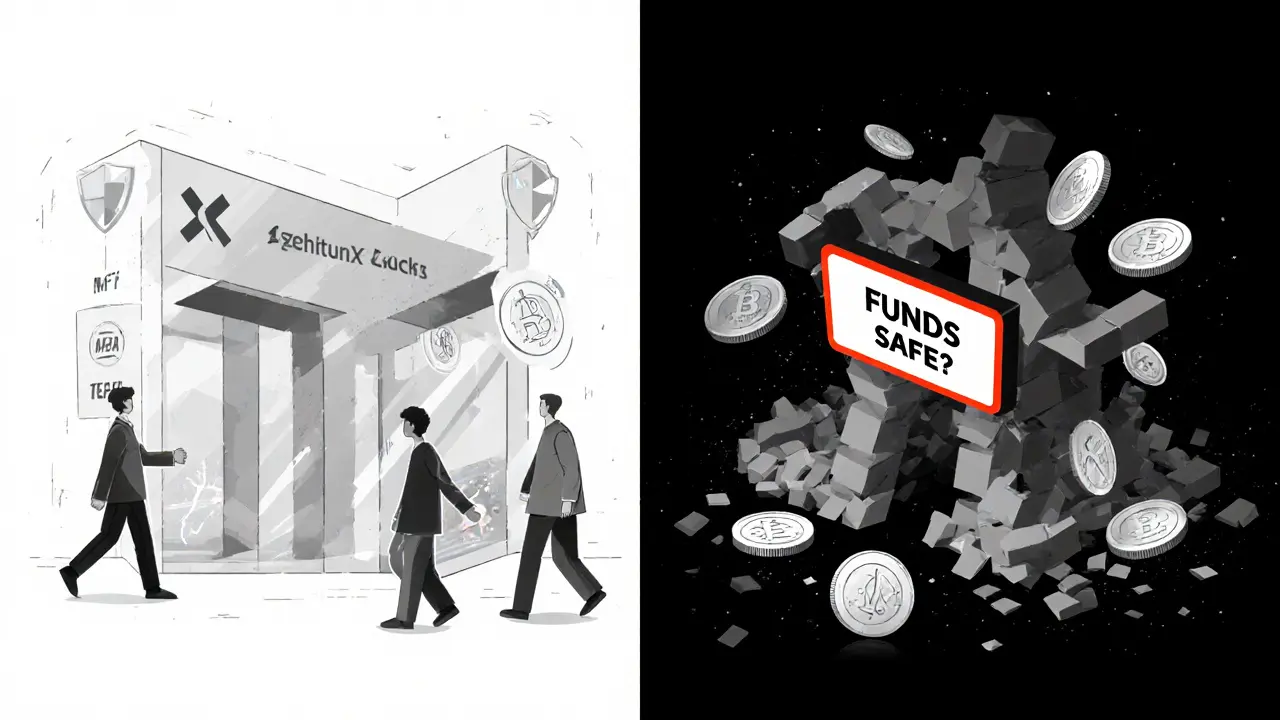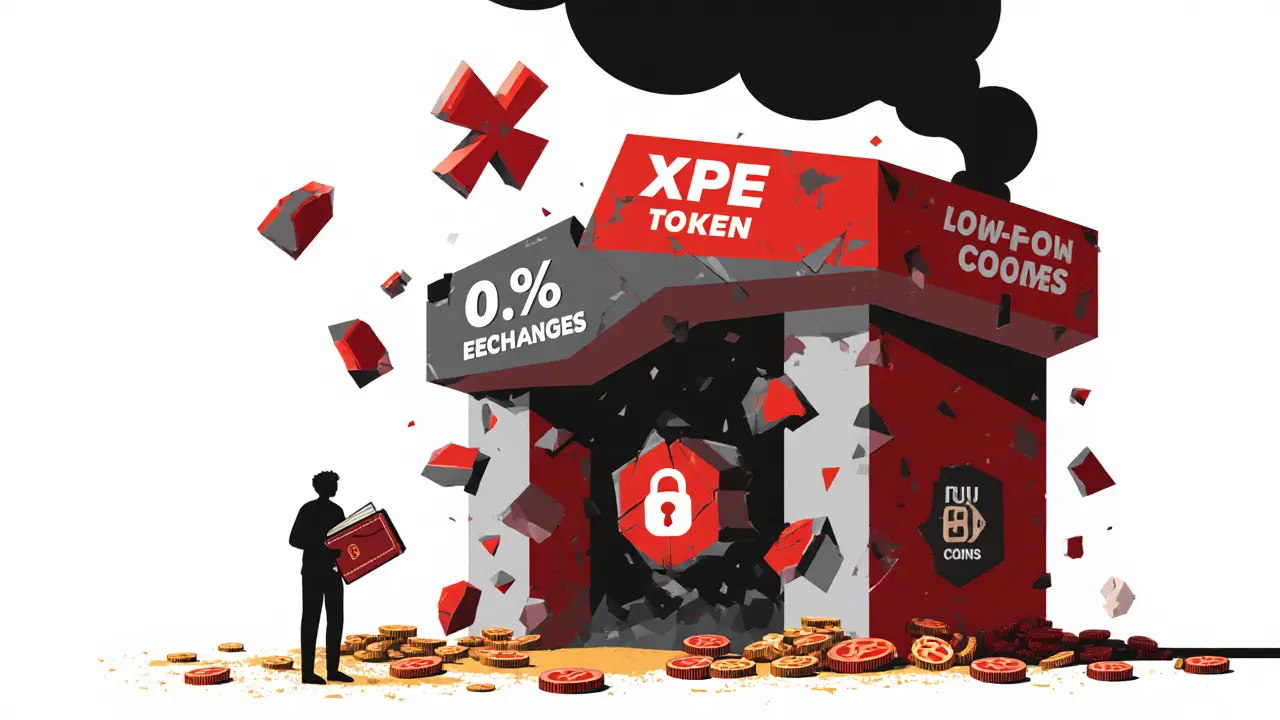Crypto Exchange Safety Checker
Check Your Exchange's Safety
Based on XeggeX's collapse, this tool helps you assess if a crypto exchange meets minimum security standards. Enter your exchange's details below.
By June 2025, XeggeX was gone. No more trading. No more customer support. No refunds. Just a blank homepage with a single notice: "Due to the hack in February and other recent issues, XeggeX is shutting down and filing for insolvency." If you had funds on XeggeX, you lost them. There’s no sugarcoating it.
What Was XeggeX?
XeggeX (pronounced "Zeg-Ex") launched in 2021 as a crypto exchange built for the fringe. While Binance and Coinbase focused on Bitcoin, Ethereum, and top-100 coins, XeggeX carved out a niche: listing obscure, low-market-cap "mining coins" others wouldn’t touch. If you wanted to trade PYI, TRL, or some new token from a Telegram group with 300 followers, XeggeX was one of the few places you could.
It wasn’t fancy. The interface was basic. The mobile app had glitches. But it promised two things: ultra-low fees (0.2% on P2P trades) and lightning-fast listings. For traders chasing quick gains on unproven coins, that was enough. At its peak, it claimed over 361,000 users and 530 assets. The numbers looked good-until they didn’t.
The XPE Token: A Promise That Never Delivered
XeggeX’s whole ecosystem revolved around its native token, XPE. Holders got 25% discounts on trading fees, withdrawal fees, and even NFT marketplace commissions. It sounded like a smart loyalty program. But here’s the catch: XPE was built on Ethereum, Binance Smart Chain, and Polygon. It had no real utility outside XeggeX’s own platform. No staking. No governance. No third-party integrations.
Users bought XPE because they were told it would save them money. But when the exchange collapsed, XPE became worthless. No exchange would list it. No wallet could recover its value. It was a digital IOU backed by a company that no longer existed.
The February 2025 Hack: How It All Crashed
The downfall didn’t come from a complex cyberattack. It came from a Telegram account.
On February 3, 2025, hackers gained access to the CEO’s personal Telegram channel. From there, they sent fake messages to internal teams, tricking staff into granting access to backend systems. Once inside, they didn’t just steal funds-they deleted database backups and locked out administrators.
Within hours, users couldn’t log in. Wallets showed $0.00. The platform responded by saying, "Funds are safe," but then admitted they’d "disconnected the database from the network" to prevent further damage. That wasn’t a fix. That was a shutdown.
There was no proof-of-reserves. No insurance. No third-party audit ever published. Just promises. And when the smoke cleared, users had no way to prove what they owned.
Why XeggeX Was a Time Bomb
XeggeX wasn’t just unlucky. It was built on bad decisions.
- Security? Barely existent. Admins used personal Telegram for critical operations. No MFA enforcement. No separation of duties.
- Listing policy? Wild west. They listed hundreds of coins with no due diligence. Many were pump-and-dumps. That attracted scammers-and made the exchange a prime target.
- Transparency? None. No public audits. No reserve proofs. No clear roadmap. Even their website didn’t list their legal entity or registered address.
- Support? Nonexistent after February. Users flooded Reddit and Trustpilot with complaints. Over 1,200 reviews averaged 1.2/5 stars. Nearly all said the same thing: "No response. Funds gone. No hope."
Compare that to Binance or Kraken. They have dedicated security teams, regular audits, and insurance funds. XeggeX had a founder with a Telegram account and a spreadsheet.
What Users Lost-and Why There’s No Recovery
People lost everything. Not just Bitcoin or Ethereum. But obscure tokens worth hundreds or thousands of dollars-coins that didn’t trade anywhere else. One Reddit user lost 3.2 BTC in mining tokens. Another lost $15,000 in a token called "RexCoin" that vanished the day after listing.
There’s no insurance. No legal recourse. The company filed for insolvency in June 2025. That means creditors-including users-are at the bottom of the repayment list. Even if assets were recovered (which they weren’t), you’d get pennies on the dollar-if anything at all.
Trustpilot archives show users pleading for updates. No replies. The official website went dark. Social media accounts vanished. This wasn’t a technical glitch. This was a full exit scam in slow motion.

Who Was Using XeggeX?
Most users were from China, Southeast Asia, and Eastern Europe. They were attracted by low fees and the chance to get in early on new coins. Many didn’t know the risks. They saw "0.2% fees" and thought it was a bargain. They didn’t realize the exchange didn’t even have basic security controls.
CoinGecko data from early 2025 showed 78% of XeggeX’s trading volume came from tokens with market caps under $50 million. That’s the exact kind of asset that gets manipulated, dumped, and abandoned. XeggeX didn’t just host these coins-it actively promoted them.
What This Means for You
XeggeX’s collapse isn’t an isolated event. In 2024-2025, 23% of exchanges with under 500,000 users suffered major security breaches. Of those, 68% never recovered.
If you’re thinking of using a small exchange that lists obscure coins, ask yourself:
- Do they publish proof-of-reserves?
- Have they been audited by a known firm?
- Do they use multi-factor authentication for all staff?
- Is their website transparent about who runs it?
If the answer to any of those is "no," walk away. The low fees aren’t worth losing your life savings.
Stick to exchanges with a proven track record. Even if their fees are higher, they have teams working 24/7 to protect your assets. XeggeX didn’t. And now, it’s gone.
Final Verdict: Don’t Even Think About It
XeggeX was never a safe exchange. It was a gamble wrapped in low fees and fast listings. And like every gamble in crypto, the house always wins.
By June 2025, it was over. No comeback. No refunds. No second chances. If you were a user, you lost. If you’re thinking of joining now, you’re too late.
There are thousands of exchanges out there. Don’t risk your crypto on one that’s already dead.
Is XeggeX still operating?
No. XeggeX officially shut down on June 27, 2025, and filed for insolvency after a major hack in February 2025. Its website is no longer functional, and all trading services have been terminated.
Can I recover my funds from XeggeX?
Almost certainly not. XeggeX filed for bankruptcy with no insurance, no proof of reserves, and no recovery plan. Users lost access to their wallets during the February 2025 hack, and balances showed as $0.00. As an insolvent entity, there are no legal mechanisms in place to return funds.
Was XeggeX regulated?
No. XeggeX operated without regulatory oversight. It was never listed on any official registry, including Canada’s authorized crypto platforms list updated in October 2025. It had no legal entity disclosed publicly and ignored basic compliance standards.
What happened to the XPE token?
The XPE token became completely worthless after XeggeX’s shutdown. It had no utility outside the exchange, and no other platform listed it. All value tied to XPE vanished with the platform. Holding XPE now is equivalent to holding a piece of paper from a defunct company.
Why did XeggeX list so many low-quality coins?
XeggeX’s business model relied on attracting speculative traders looking for early access to new, low-market-cap tokens. By listing coins others refused, it gained user growth quickly. But this also made it a magnet for scams and pump-and-dump schemes, increasing risk for users and making the platform a target for hackers.
How did the hackers break into XeggeX?
Hackers compromised the CEO’s personal Telegram account, which was used for internal communications. From there, they tricked staff into granting access to backend systems. This was a fundamental security failure-critical administrative tasks should never be handled over personal messaging apps without multi-factor authentication.
Should I avoid small crypto exchanges?
Not all small exchanges are unsafe, but XeggeX shows how quickly things can go wrong. Always check for proof-of-reserves, third-party audits, transparent leadership, and strong security practices. If an exchange doesn’t provide these, treat it as high-risk. Your crypto isn’t worth gambling on.
